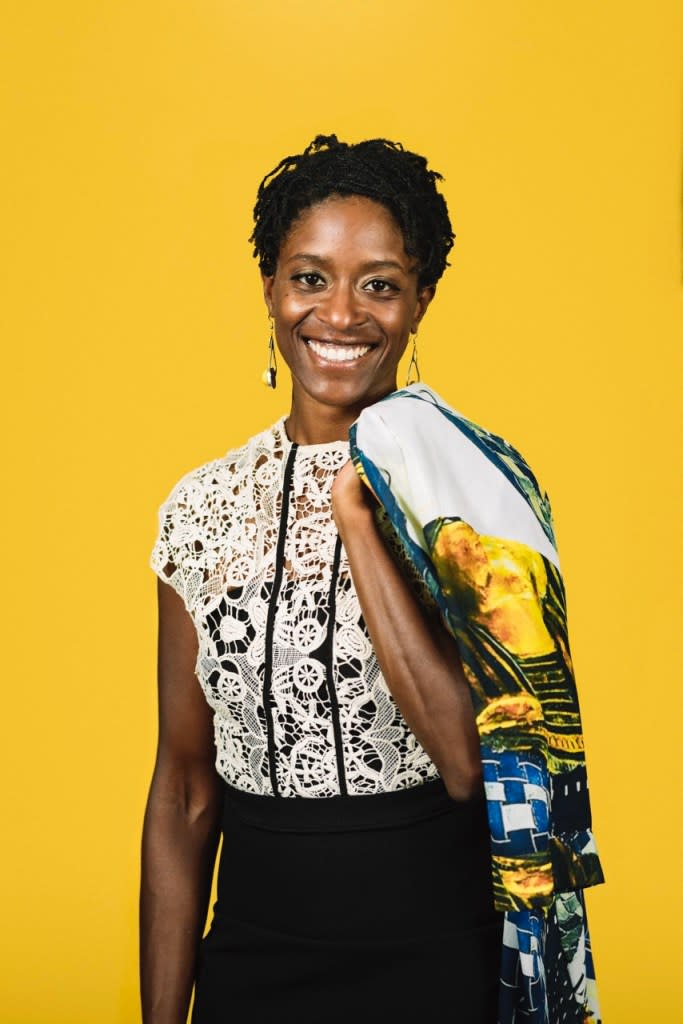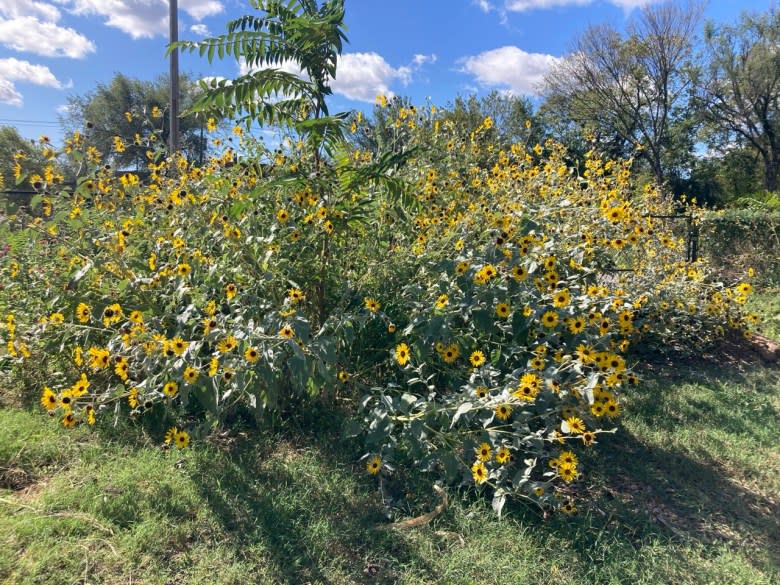This Black Artist Is Using Farming to Heal Herself — and the Land
If you were to drive down Interstate 70 in St. Louis’ predominantly Black North Side today, you’d be greeted by a billboard with the phrase “Listen to your Elders.” Behind those words, a 1970s-era photo of Dail Chambers’ aunt and uncle, Mary and Dubell, illustrates one of the thorny realities of Black history and the result of urban development and the Great Migration.
“In the back of them, you see a subdivision of new homes and cotton fields in between and behind the homes, the same cotton fields my family worked,” Chambers, an artist and farmer, explained about the billboard she recently designed and had erected. While the sight of the cotton fields conjures thoughts of the forced labor of enslaved people, it also exposes a contentious yet once-central tenet of Black life: farming.

Two generations ago, Chambers’ family, like tens of thousands of other Black families, migrated from the South, the Mississippi Delta in particular, to the Midwest. With them, the tens of thousands of Black folks left their mark on the Midwest, making Black life inseparable from the fabric of daily life in the region. But it also separated Blackness from nature, and at the same time, as subdivisions and urban development took off, it locked Black families out of new land ownership opportunities.
As Southern Black migration began around World War I, an estimated 950,000 Black farmers owned about 20 million acres of land. Today, fewer than 50,000 Black farmers exist, and just 25% of the land remains in Black hands.
“When Black people moved into more industrial cities, many became less aware of our connection with the environment because of the pace of life, and it feels like being more aware of this relationship is a more Southern gift,” Chambers said.
Read More: Her Family’s Land Was Stolen. Now, She’s Helping Black Farmers Keep Theirs.
Chambers only realized this after a personal and ongoing journey, which brought her back to her family’s Southern home of Clarksdale, Mississippi. Ultimately deciding to first leave St. Louis after the Ferguson Uprising and the police killing of Black teenager Michael Brown, over the past several years the activist has split time living in St. Louis and the Mississippi Delta. Throughout this time, she has worked to regain a relationship with the land, hoping to instill “harvesting, farming, and planting as a life practice” for Black folks in both regions.
“In both places, Black culture has focused on surviving in the face of how the built environment has been created to discriminate against us and removed us from our roots in nature.”
For Black History Month, Capital B caught up with Chambers to learn more about how she has traced her family’s migratory path along the Mississippi River, and has used her newfound knowledge to bring urban farming to St. Louis and to promote homestead living in the Mississippi Delta in the face of climate threats.
“I’m archiving my family history and realizing the lifestyle of my ancestors as a way to intergenerationally heal and also literally heal the land.”

Capital B: What connection do you think there is between environmental justice and farming to your family’s migration history, and just the general migration history of Black folks between the South and the Midwest?
Dail Chambers: Knowing that for both cities, the Mississippi River has been a trade river. It shows me directly how connected we all are and in how many ways we are all related. (Many of the nation’s majority-Black cities and towns are found along the Mississippi River, as it has guided migration routes and entire economies around electricity generation, agricultural, and industrial production.) And when I say you’re all related, not just like the physical and social conditions of the space, but even the native plants, like the Elderberry, Brown-eyed Susans, and the Echinacea.
Read More: These Maps Show the Risks of the New Great Migration
For me, this work is within a larger movement to rewrite narratives and reclaim the land in a way that will clean up some of the pollution we’ve been having to work through in both cities. When we look at the socioeconomic issues in the Midwest and South, I don’t think we can explain one without the other. I think we, as migratory people, as sustainable folk, have to keep our Southern ways because some of the Southern ways are exactly what originally taught us to not only survive but thrive under any condition, even when it’s not the best in this country.
Harriet Tubman is a perfect example of this history; when you go to Harriet Tubman’s house, they know that she kept strawberry seeds in her walls so that she could have the ability to grow them when she needed food on her journeys. And I think that’s just the native and the African way.
As Black folks are trying to figure out where exactly to set their roots, is this practice of splitting time between two places something that you would suggest?
When I’m in Mississippi, I’m there to be myself and to learn. I don’t come with my own agenda, although I’m doing the homestead down there. I’m responding to not only my needs, but the needs of my community around me.
I think it’s possible for Black folks to be thriving, no matter where we are. Still, I also know for us to have these safe places as society shifts is going to be more and more important, especially for those of us who grow food, because the land is limited and growth patterns are changing.
But with climate change happening, we’re really not going to have much of a choice, in some cases, anyway, so ultimately, it is about working within your means and understanding that small-scale farming practices can be used everywhere.
Can you explain what your homesteading in Mississippi and your urban farming and in St. Louis, looks like?
I’m focused on a lot of native foods and native plants because the perennial plant is what allows me to be in multiple spaces. By supporting native plant species, we can promote ecosystem health and resilience. They reduce the amount of carbon dioxide in the atmosphere, use less water, promote soil health and fertility, and support flood control.
For instance, I grow a lot of chokeberries, strawberries, and black cherry trees, and particularly in Mississippi, I’m growing strawberries, sage, and elderberry.
On my urban farm site in St. Louis, I have a more varied growth diversity because of the access to seeds and plants being in an urban environment. But I feel as though in Mississippi that, I have a steadier growth plan, and one that’s a little bit more sustainable.
How would you place the work that you’re doing right now and your family’s story within the larger lineage of Black and migratory history?
I’m a big fan of Zora Neale Hurston, Ida B. Wells, Ella Baker, Fannie Lou Hamer; see, my people used to live in Sunflower County, Mississippi, during the same time that Fannie Lou Hamer was doing her organizing work there. So I’m deeply inspired by those women. This work is deeply inspired by Elizabeth Catlett, and I’m deeply inspired by Phillis Wheatley, the first published Black woman. So she’s the one who opened up the door for us. And of course, Harriet Tubman. Everyone thinks about her being this courageous woman that saved everybody from the South. But she was a grower, a farmer. She was an environmentalist, and we forget that she was advocating for sustainable living.
Read More: Why Saving This Stop on the Underground Railroad Is an Act of Climate Justice
Can this reconnection to the land also be a pathway toward adapting to climate threats?
I think having a food forest or even working with neighbors or one of the many community organizations around you to plant better, more mature trees, healing herbs and berries, and seasonal vegetables is attainable for most people, even if they’re coming from a socioeconomic environment that has been attacked. And I think that it will heal so many of the climate issues, from flooding to air pollution.
Find an urban farm near you: https://www.urbanfarming.org/garden-locations.html
The post This Black Artist Is Using Farming to Heal Herself — and the Land appeared first on Capital B News.

